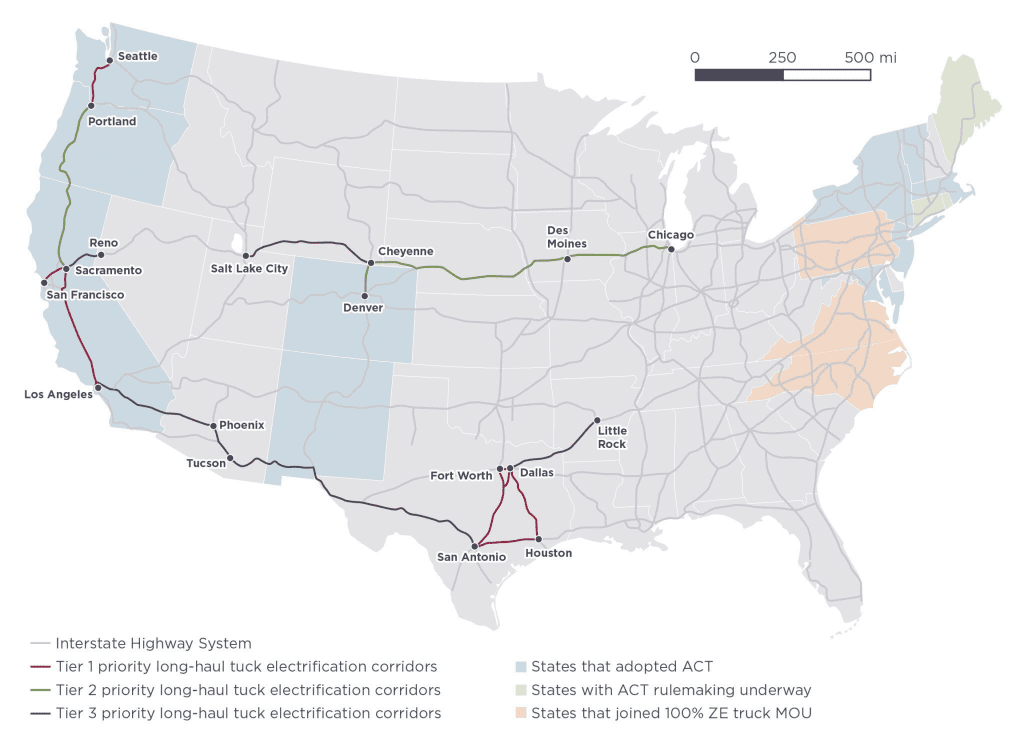By Chris Grundler, Senior Advisor to the Crux Alliance, and former Director of the Office of Transportation and Air Quality at the Environmental Protection Agency.
Two new regulations recently adopted by the U.S. Environmental Protection Agency (EPA) promise to drive more electrification—and more emissions reductions—in the transportation sector, the top source of U.S. carbon emissions. The International Council on Clean Transportation (ICCT), the Crux Alliance’s lead for vehicles, contributed to both historic results. ICCT Board Chair Emeritus and former EPA vehicle and fuels regulator Margo Oge described the rule governing passenger vehicles as “the single most important climate pollution regulations in the nation’s history” and the rule governing commercial trucks as “the strongest-ever greenhouse gas standards covering new medium and heavy-duty trucks” in the U.S.
The rule for new passenger vehicles applies to model year 2027 and beyond. The requirements are expected to significantly reduce emissions of greenhouse gases, hydrocarbons, nitrogen oxides, and particulate matter from new cars, light trucks, and larger pickups and vans. Depending on the pollutant, by 2032 the fleet average emissions targets will be 50 to 70 percent cleaner relative to the 2026 new car fleet. Cumulative reductions in climate pollution over the lifetime of the program are projected to be approximately 7.2 billion metric tons. The EPA estimates that the standards will provide $13 billion in health benefits every year as a result of reduced emissions of pollutants that contribute to concentrations of small particles in the air. The EPA further estimates that the standards will reduce particle pollution from new gasoline vehicles by over 95 percent.

The requirements for new trucks also take effect beginning in model year 2027. They cover a diverse range of commercial vehicles, like delivery trucks, school buses, and long-haul tractor trailers. Projected emissions reductions vary by vehicle category and are expected to total approximately 1 billion metric tons of greenhouse gas emissions over the life of the program, alongside $300 million in annual health benefits. Depending on the type of truck, a new truck in 2032 will be up to 60 percent cleaner relative to a 2026 truck, cutting air pollution for the 72 million people who live near major truck freight routes.
Both rules are technology neutral and performance based. This means there are no mandated technologies; rather, manufacturers can choose which technologies to apply to the vehicles they produce. However, the EPA expects the standards will result in a significant percentage of new electric cars and trucks being introduced to the market based on a detailed technology and cost analysis. This is because building and selling electric vehicles will often be the most cost effective way to achieve the standards. The EPA estimates the light-duty rule could result in a 53 percent electric vehicle share in 2030, including 44 percent battery electric and 9 percent plug-in hybrid electric. By 2032, the EPA estimates a 68 percent plug-in electric vehicle share, including 56 percent battery electric and 13 percent plug-in hybrid.
I spoke to Rachel Muncrief, Deputy Director of the ICCT, about both rules and the technical contributions the ICCT made during the development of the proposed and final standards. She noted that the final passenger vehicle standards put the U.S. close to the most advanced markets in the world. Rachel said that “this is a historic step forward for the U.S. We’re now on a closer path toward meeting our decarbonization goals.” The EPA’s new commercial truck standards, while making significant progress, still lag standards in California and Europe, which in general require a greater percentage of emissions reductions across truck categories, and in the case of California require a percentage of new trucks to produce zero emissions.

Rachel described the key role the ICCT played in supporting the development of these two major regulations. The ICCT’s timely and credible research helped the EPA demonstrate the technical feasibility, achievability, and cost effectiveness of the passenger vehicle standards. Rachel said that, in fact, the EPA referenced 13 ICCT materials in the technical analysis underpinning the rule. A particularly critical contribution was an analysis done with Energy Innovation that projected electric vehicle sales in response to the incentives in the Inflation Reduction Act. The analysis showed that as a result of those incentives, the EPA could set more stringent standards than would have been possible otherwise, at lower cost and higher benefit to consumers and manufacturers. This provided an updated baseline for the rule, from which the EPA developed its policy going forward. Rachel commented, “We believe that good research and analysis is the foundation for good policy. The ICCT’s work to support the EPA’s groundbreaking new rules through clear, objective analysis once again proves that.”
Rachel noted that in developing the commercial truck rule, the EPA faced criticism from manufacturers, vehicle operators, and oil and gas companies. “The first most impactful thing we did was to provide the EPA the evidence base to support adoption of the rule. Our research provided the EPA with the technical underpinnings to support technology feasibility and cost effectiveness to overcome these challenges.” As with the passenger vehicle rule, the EPA referenced 13 ICCT reports in the final truck rule.

Rachel also shared details of the ICCT’s work to address concerns about electrification infrastructure. “The second most impactful thing we did was support the EPA’s decision not to weaken standards because of concerns about the infrastructure needed to support electrification,” she said. The industry argued the EPA should provide an “off ramp”—essentially, an escape clause in the final rule that would weaken the standards if charging infrastructure did not develop at a predetermined pace. To rebut this proposal, the ICCT developed an analysis that detailed where, when, and how much infrastructure needs to be available to serve the number of battery electric trucks that manufacturers are expected to produce over time. The ICCT’s work—cited by the EPA in the final regulation—showed that infrastructure does not need to be built everywhere, all at once.

Moreover, the ICCT’s analysis formed the basis of the new U.S. National Zero Emission Freight Corridor Strategy (announced on March 12, 2024) which, among other features, defines strategic locations for infrastructure deployment in the highest-priority ports, industrial zones, and freight corridors. The release of this strategy provided the EPA with a response to industry infrastructure concerns that allowed the agency to move forward with adopting the new truck rule.
Together, these two rules will significantly reduce U.S. transportation pollution. The passenger vehicle standards alone are expected to eliminate the equivalent of seven years of carbon pollution from today’s vehicles. These actions are also essential steps on the journey toward achieving the U.S. goal of halving carbon pollution by 2030. And they provide a case study on the important role and critical contributions nonpartisan, objective research organizations like the ICCT make in developing impactful policies to address the climate crisis.
The task for ICCT now is to continue to monitor the rapidly changing landscape of vehicle technologies, charging infrastructure, and markets. Defending and implementing the EPA standards will be critical to ensuring people and the planet enjoy the projected benefits. The lesson of the Volkswagen “Dieselgate” saga is that establishing ambitious standards is just the first step—the results ultimately depend on effective implementation, compliance monitoring, and enforcement.

